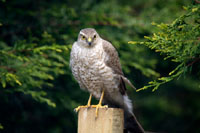Sparrowhawks – at home in the South-West

Much has been made of the RSPB's magnificent programme to reintroduce the Red Kite in Wales and many areas of England in recent years.
Their hugely successful efforts have been widely publicised, but over the same period the recovery in the numbers of another British bird of prey has been equally, if not more impressive, especially since the species has achieved this remarkable renaissance with just one vital piece of human intervention.
This fact was again excitingly illustrated last summer when a pair of sparrowhawks set up home for the first time in a small South East Cornwall coniferous wood, parts of which were recently sold by Woodlands.co.uk.
The hawks successfully raised five young, despite building their nest literally feet from one of the busiest 'A' roads in Cornwall.
The couple who recently bought half the wood were thrilled to learn that with luck, the sparrowhawks will return this year, and the new owners will be able to witness at close hand a sight that would have been unthinkable 30 or 40 years ago.
Then, the widespread use of certain agricultural chemicals was making sparrowhawk eggs incredibly fragile, resulting in a massive decline in the reproductive success of the birds and, consequently, their numbers. The threat of extinction in the UK was a very real one.
Under pressure, the government eventually stepped in and banned the offending substances. Gradually, the birds returned to the areas where they once flourished, and there are now reckoned to be about 30,000 pairs.
Sparrowhawks still arouse plenty of controversy, not least because they often take small birds. But I would refer anyone who believes they represent a threat to some of our best-loved songsters to a well-documented study of an Oxfordshire wood which revealed that the numbers of small prey birds remained exactly the same when sparrowhawks temporarily disappeared during the 'crisis' and did NOT decrease when they eventually returned.
For me, there is no finer sight in this country than a sparrowhawk flying low along a narrow country road, or circling high up in a clear sky, as they often do in the spring.
I know the couple who have invested in that little wood will agree with me when they find out just what a marvellous bird they have living in their patch of green heaven...
Comments are closed for this post.
Discussion
I regularly have a sparrowhawk fly through my urban garden in Eastbourne. It has a preference for starlings and often either cannot stop as it is flying too fast or deliberately hits the front or back of the house and ends up in the garden with the starling in its claws before flying off for its meal.
It also sits in my willow tree and looks down on my pond! I think the fish are safe though.
We have to accept that this is nature doing its job.

Have just watched and photographed a female sparrowhawk plucking and eating a pigeon for breakfast – unusually she was on the ground and not too bothered by us.
Lynda Lindfield
1 November, 2012